In-Depth Analysis of Fingerprint Authentication Systems & Technologies
VerifiedAdded on 2023/06/04
|18
|4660
|400
Report
AI Summary
This report provides an in-depth analysis of fingerprint authentication systems, exploring their underlying principles, strengths, and limitations. It begins by introducing the concept of fingerprint uniqueness and its application in various fields, highlighting the importance of fingerprint image quality in authentication processes. The report discusses the advantages of fingerprint authentication, such as high security and user convenience, while also addressing common errors and constraints, including financial limitations and the challenges of converting 3D fingerprints into 2D images. It examines optical, capacitive, thermal, and ultrasound scanning technologies, noting the emergence of 3D image detection systems to mitigate existing problems. The research questions focus on identifying problems associated with fingerprint authentication systems and evaluating recent technologies to reduce such issues, emphasizing the need for organizations to explore innovative detection technologies to prevent security breaches and improve employee satisfaction. The report also touches upon the financial considerations for implementing advanced security devices and the importance of understanding factors influencing fingerprint authentication implementation.
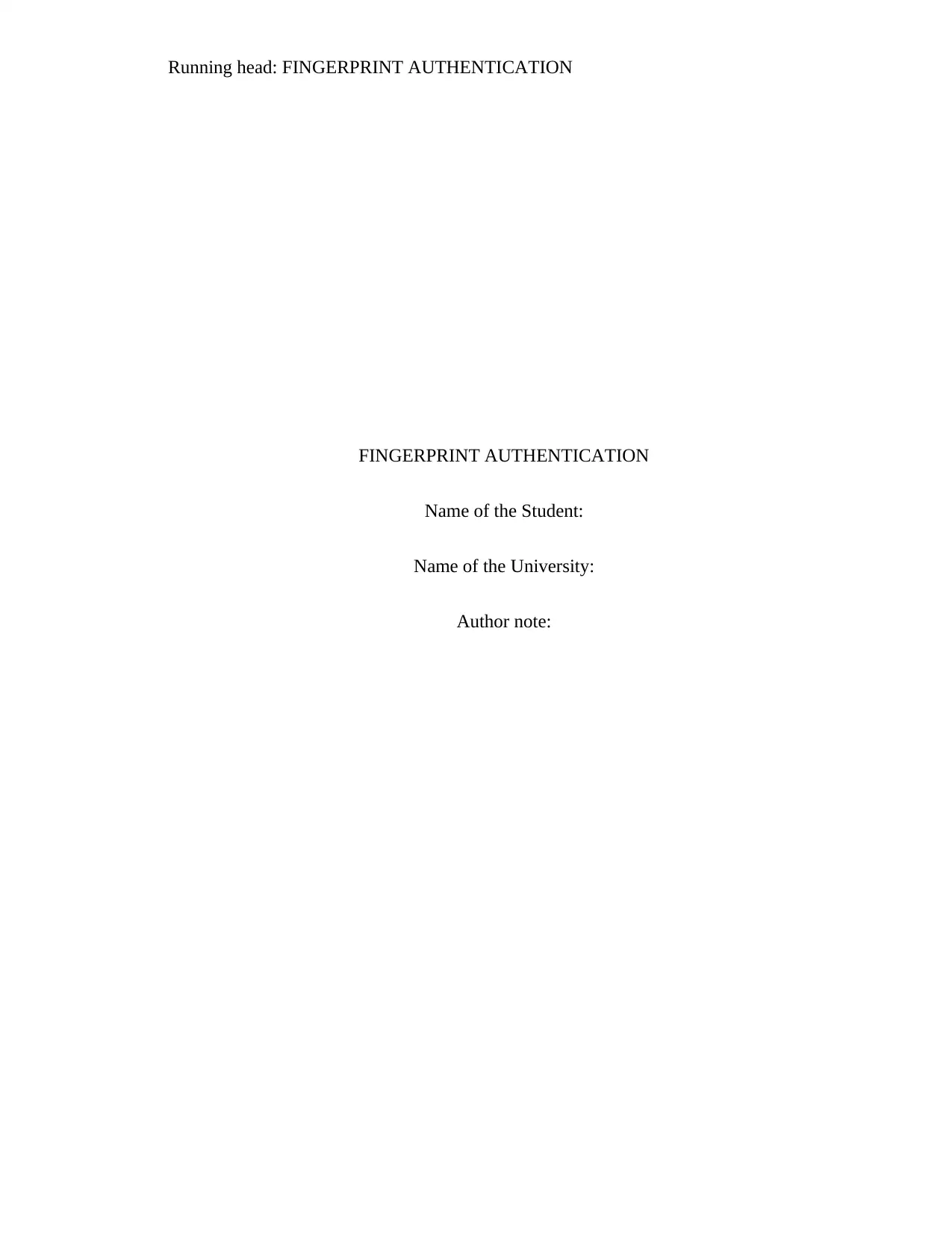
Running head: FINGERPRINT AUTHENTICATION
FINGERPRINT AUTHENTICATION
Name of the Student:
Name of the University:
Author note:
FINGERPRINT AUTHENTICATION
Name of the Student:
Name of the University:
Author note:
Paraphrase This Document
Need a fresh take? Get an instant paraphrase of this document with our AI Paraphraser
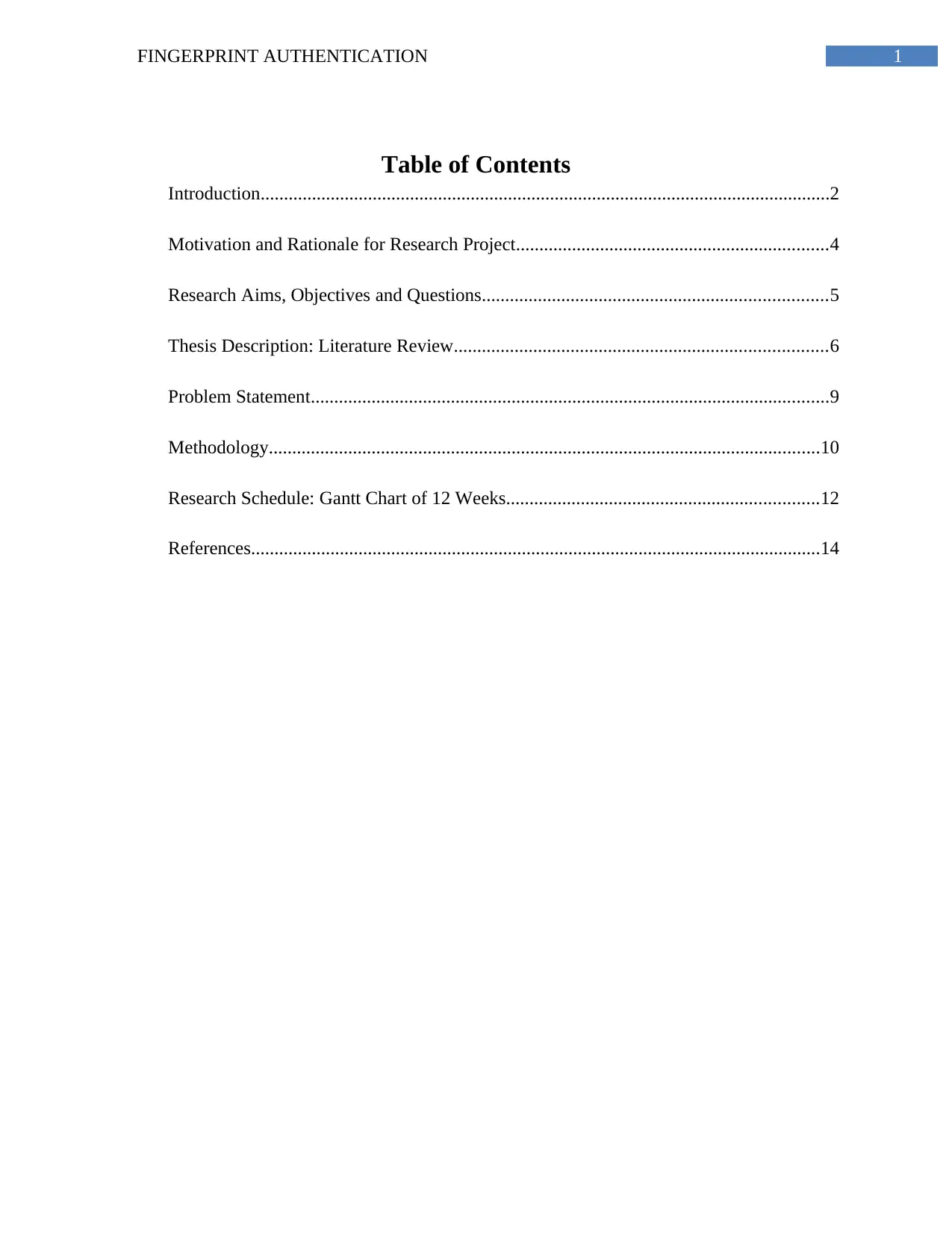
1FINGERPRINT AUTHENTICATION
Table of Contents
Introduction..........................................................................................................................2
Motivation and Rationale for Research Project...................................................................4
Research Aims, Objectives and Questions..........................................................................5
Thesis Description: Literature Review................................................................................6
Problem Statement...............................................................................................................9
Methodology......................................................................................................................10
Research Schedule: Gantt Chart of 12 Weeks...................................................................12
References..........................................................................................................................14
Table of Contents
Introduction..........................................................................................................................2
Motivation and Rationale for Research Project...................................................................4
Research Aims, Objectives and Questions..........................................................................5
Thesis Description: Literature Review................................................................................6
Problem Statement...............................................................................................................9
Methodology......................................................................................................................10
Research Schedule: Gantt Chart of 12 Weeks...................................................................12
References..........................................................................................................................14
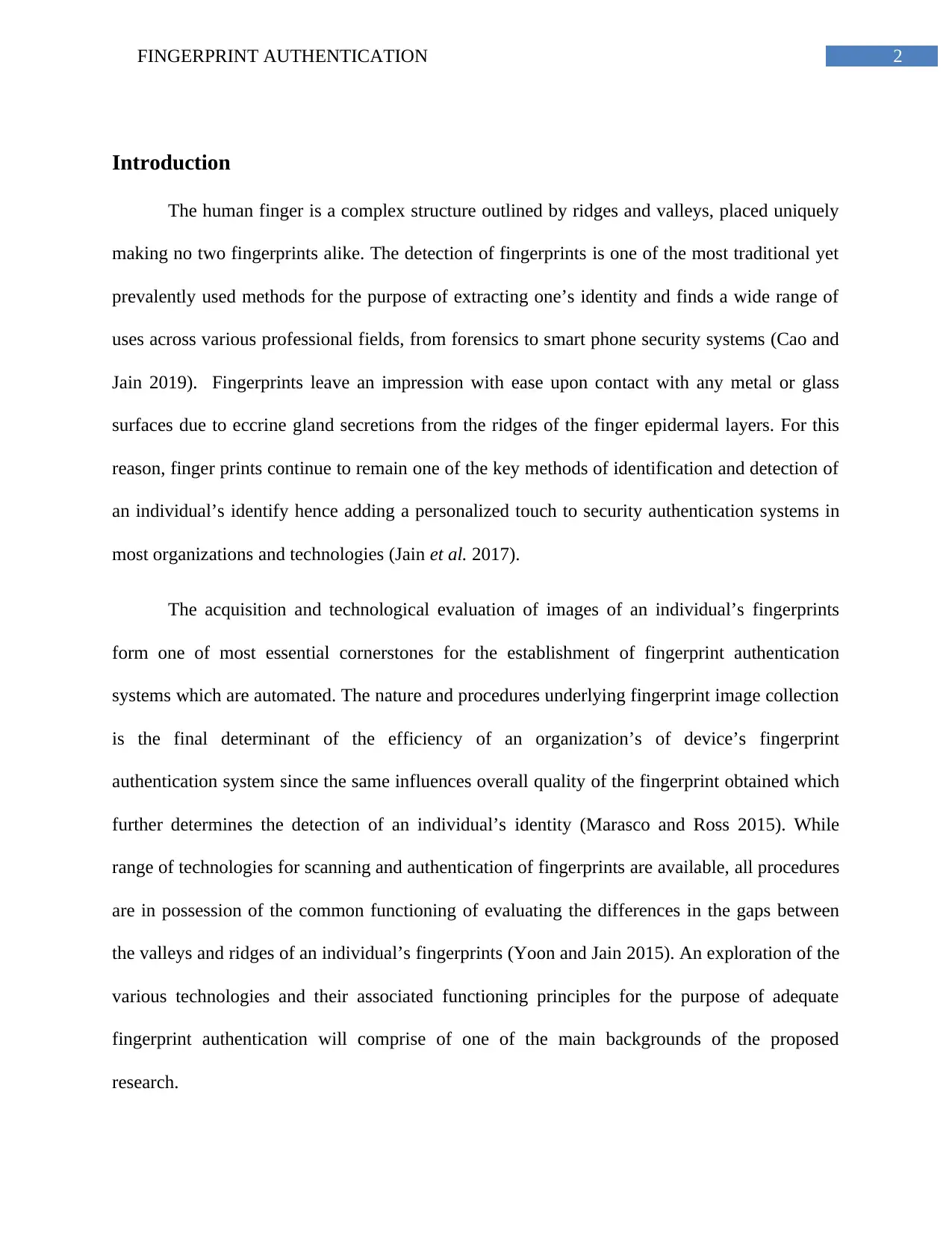
2FINGERPRINT AUTHENTICATION
Introduction
The human finger is a complex structure outlined by ridges and valleys, placed uniquely
making no two fingerprints alike. The detection of fingerprints is one of the most traditional yet
prevalently used methods for the purpose of extracting one’s identity and finds a wide range of
uses across various professional fields, from forensics to smart phone security systems (Cao and
Jain 2019). Fingerprints leave an impression with ease upon contact with any metal or glass
surfaces due to eccrine gland secretions from the ridges of the finger epidermal layers. For this
reason, finger prints continue to remain one of the key methods of identification and detection of
an individual’s identify hence adding a personalized touch to security authentication systems in
most organizations and technologies (Jain et al. 2017).
The acquisition and technological evaluation of images of an individual’s fingerprints
form one of most essential cornerstones for the establishment of fingerprint authentication
systems which are automated. The nature and procedures underlying fingerprint image collection
is the final determinant of the efficiency of an organization’s of device’s fingerprint
authentication system since the same influences overall quality of the fingerprint obtained which
further determines the detection of an individual’s identity (Marasco and Ross 2015). While
range of technologies for scanning and authentication of fingerprints are available, all procedures
are in possession of the common functioning of evaluating the differences in the gaps between
the valleys and ridges of an individual’s fingerprints (Yoon and Jain 2015). An exploration of the
various technologies and their associated functioning principles for the purpose of adequate
fingerprint authentication will comprise of one of the main backgrounds of the proposed
research.
Introduction
The human finger is a complex structure outlined by ridges and valleys, placed uniquely
making no two fingerprints alike. The detection of fingerprints is one of the most traditional yet
prevalently used methods for the purpose of extracting one’s identity and finds a wide range of
uses across various professional fields, from forensics to smart phone security systems (Cao and
Jain 2019). Fingerprints leave an impression with ease upon contact with any metal or glass
surfaces due to eccrine gland secretions from the ridges of the finger epidermal layers. For this
reason, finger prints continue to remain one of the key methods of identification and detection of
an individual’s identify hence adding a personalized touch to security authentication systems in
most organizations and technologies (Jain et al. 2017).
The acquisition and technological evaluation of images of an individual’s fingerprints
form one of most essential cornerstones for the establishment of fingerprint authentication
systems which are automated. The nature and procedures underlying fingerprint image collection
is the final determinant of the efficiency of an organization’s of device’s fingerprint
authentication system since the same influences overall quality of the fingerprint obtained which
further determines the detection of an individual’s identity (Marasco and Ross 2015). While
range of technologies for scanning and authentication of fingerprints are available, all procedures
are in possession of the common functioning of evaluating the differences in the gaps between
the valleys and ridges of an individual’s fingerprints (Yoon and Jain 2015). An exploration of the
various technologies and their associated functioning principles for the purpose of adequate
fingerprint authentication will comprise of one of the main backgrounds of the proposed
research.
⊘ This is a preview!⊘
Do you want full access?
Subscribe today to unlock all pages.

Trusted by 1+ million students worldwide
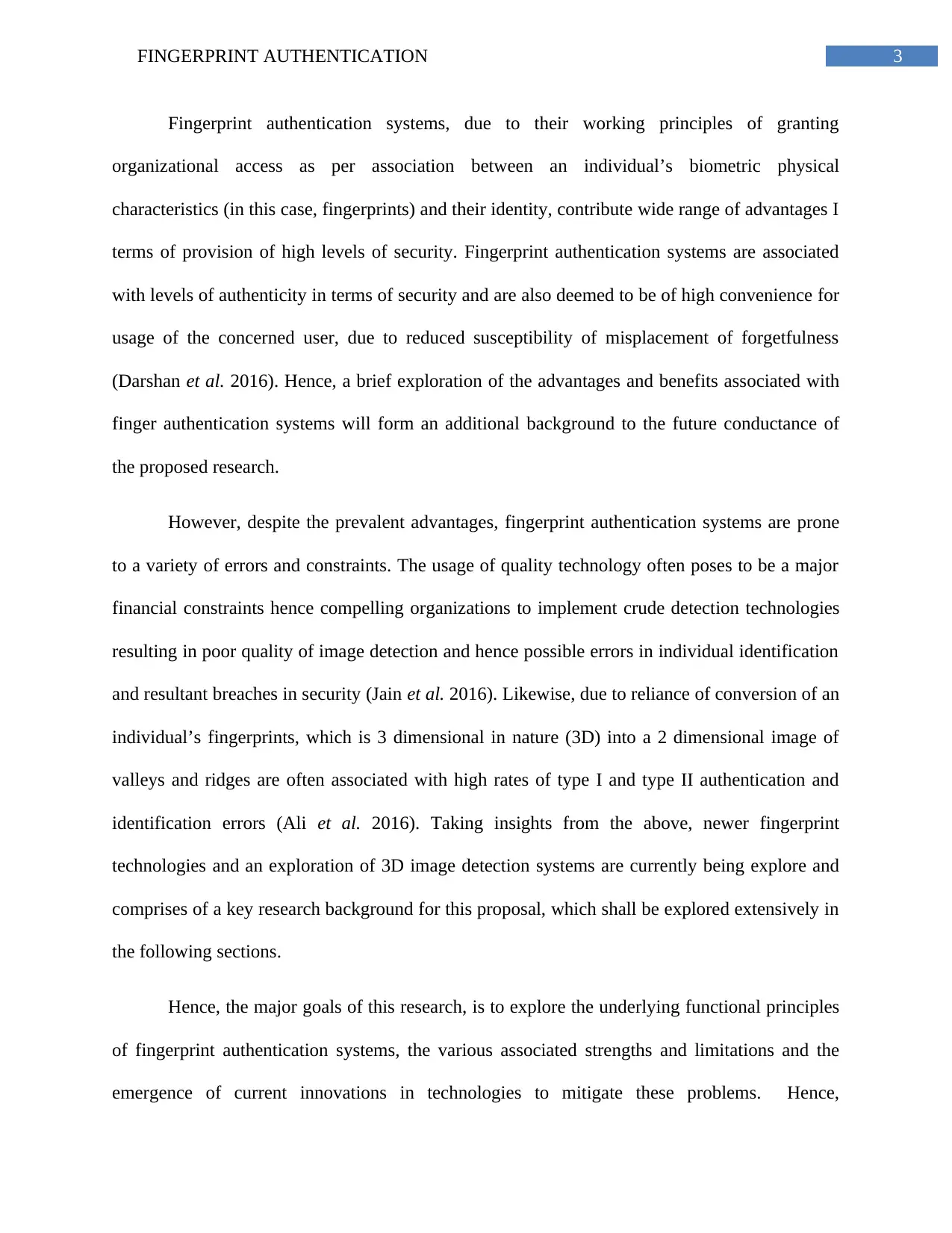
3FINGERPRINT AUTHENTICATION
Fingerprint authentication systems, due to their working principles of granting
organizational access as per association between an individual’s biometric physical
characteristics (in this case, fingerprints) and their identity, contribute wide range of advantages I
terms of provision of high levels of security. Fingerprint authentication systems are associated
with levels of authenticity in terms of security and are also deemed to be of high convenience for
usage of the concerned user, due to reduced susceptibility of misplacement of forgetfulness
(Darshan et al. 2016). Hence, a brief exploration of the advantages and benefits associated with
finger authentication systems will form an additional background to the future conductance of
the proposed research.
However, despite the prevalent advantages, fingerprint authentication systems are prone
to a variety of errors and constraints. The usage of quality technology often poses to be a major
financial constraints hence compelling organizations to implement crude detection technologies
resulting in poor quality of image detection and hence possible errors in individual identification
and resultant breaches in security (Jain et al. 2016). Likewise, due to reliance of conversion of an
individual’s fingerprints, which is 3 dimensional in nature (3D) into a 2 dimensional image of
valleys and ridges are often associated with high rates of type I and type II authentication and
identification errors (Ali et al. 2016). Taking insights from the above, newer fingerprint
technologies and an exploration of 3D image detection systems are currently being explore and
comprises of a key research background for this proposal, which shall be explored extensively in
the following sections.
Hence, the major goals of this research, is to explore the underlying functional principles
of fingerprint authentication systems, the various associated strengths and limitations and the
emergence of current innovations in technologies to mitigate these problems. Hence,
Fingerprint authentication systems, due to their working principles of granting
organizational access as per association between an individual’s biometric physical
characteristics (in this case, fingerprints) and their identity, contribute wide range of advantages I
terms of provision of high levels of security. Fingerprint authentication systems are associated
with levels of authenticity in terms of security and are also deemed to be of high convenience for
usage of the concerned user, due to reduced susceptibility of misplacement of forgetfulness
(Darshan et al. 2016). Hence, a brief exploration of the advantages and benefits associated with
finger authentication systems will form an additional background to the future conductance of
the proposed research.
However, despite the prevalent advantages, fingerprint authentication systems are prone
to a variety of errors and constraints. The usage of quality technology often poses to be a major
financial constraints hence compelling organizations to implement crude detection technologies
resulting in poor quality of image detection and hence possible errors in individual identification
and resultant breaches in security (Jain et al. 2016). Likewise, due to reliance of conversion of an
individual’s fingerprints, which is 3 dimensional in nature (3D) into a 2 dimensional image of
valleys and ridges are often associated with high rates of type I and type II authentication and
identification errors (Ali et al. 2016). Taking insights from the above, newer fingerprint
technologies and an exploration of 3D image detection systems are currently being explore and
comprises of a key research background for this proposal, which shall be explored extensively in
the following sections.
Hence, the major goals of this research, is to explore the underlying functional principles
of fingerprint authentication systems, the various associated strengths and limitations and the
emergence of current innovations in technologies to mitigate these problems. Hence,
Paraphrase This Document
Need a fresh take? Get an instant paraphrase of this document with our AI Paraphraser
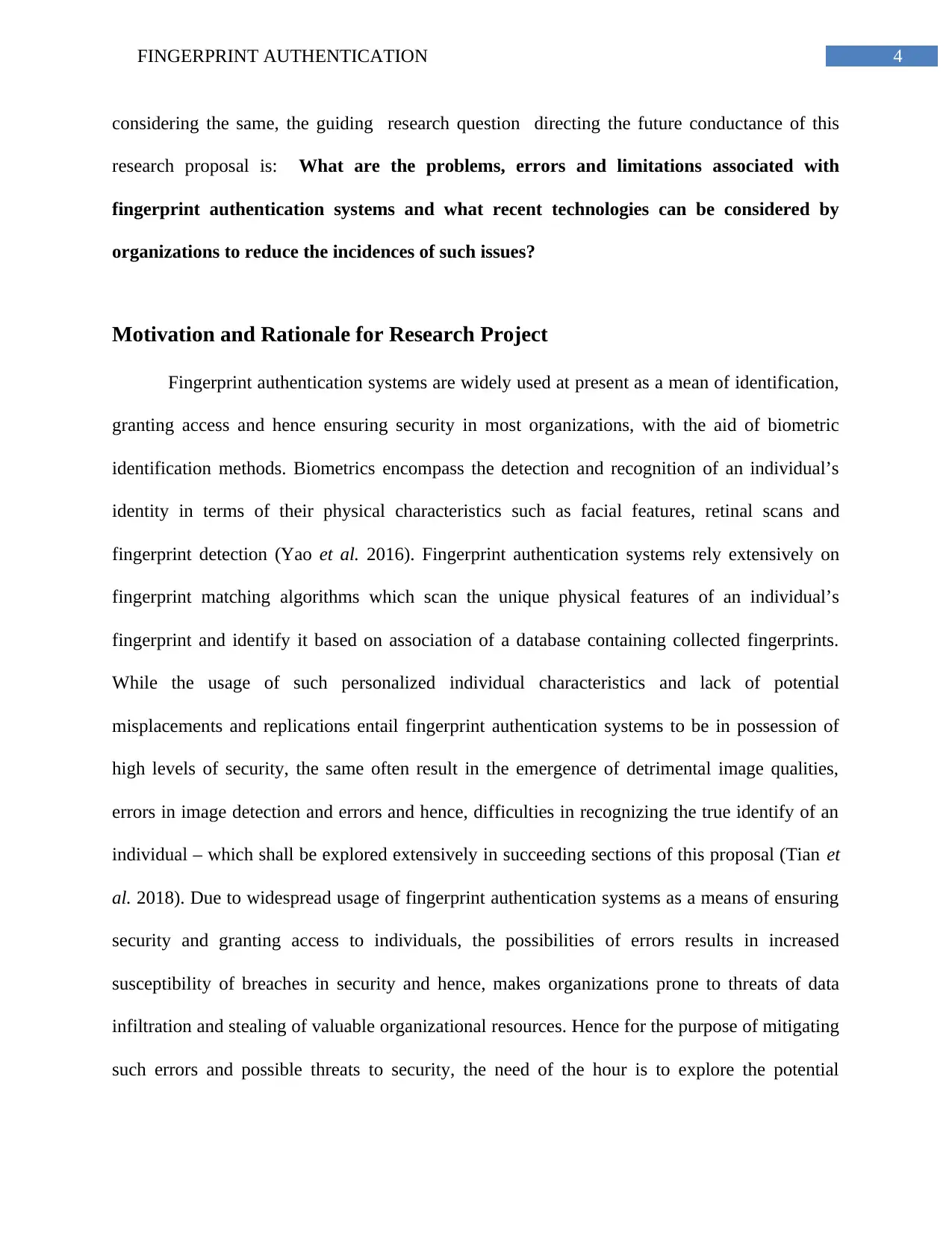
4FINGERPRINT AUTHENTICATION
considering the same, the guiding research question directing the future conductance of this
research proposal is: What are the problems, errors and limitations associated with
fingerprint authentication systems and what recent technologies can be considered by
organizations to reduce the incidences of such issues?
Motivation and Rationale for Research Project
Fingerprint authentication systems are widely used at present as a mean of identification,
granting access and hence ensuring security in most organizations, with the aid of biometric
identification methods. Biometrics encompass the detection and recognition of an individual’s
identity in terms of their physical characteristics such as facial features, retinal scans and
fingerprint detection (Yao et al. 2016). Fingerprint authentication systems rely extensively on
fingerprint matching algorithms which scan the unique physical features of an individual’s
fingerprint and identify it based on association of a database containing collected fingerprints.
While the usage of such personalized individual characteristics and lack of potential
misplacements and replications entail fingerprint authentication systems to be in possession of
high levels of security, the same often result in the emergence of detrimental image qualities,
errors in image detection and errors and hence, difficulties in recognizing the true identify of an
individual – which shall be explored extensively in succeeding sections of this proposal (Tian et
al. 2018). Due to widespread usage of fingerprint authentication systems as a means of ensuring
security and granting access to individuals, the possibilities of errors results in increased
susceptibility of breaches in security and hence, makes organizations prone to threats of data
infiltration and stealing of valuable organizational resources. Hence for the purpose of mitigating
such errors and possible threats to security, the need of the hour is to explore the potential
considering the same, the guiding research question directing the future conductance of this
research proposal is: What are the problems, errors and limitations associated with
fingerprint authentication systems and what recent technologies can be considered by
organizations to reduce the incidences of such issues?
Motivation and Rationale for Research Project
Fingerprint authentication systems are widely used at present as a mean of identification,
granting access and hence ensuring security in most organizations, with the aid of biometric
identification methods. Biometrics encompass the detection and recognition of an individual’s
identity in terms of their physical characteristics such as facial features, retinal scans and
fingerprint detection (Yao et al. 2016). Fingerprint authentication systems rely extensively on
fingerprint matching algorithms which scan the unique physical features of an individual’s
fingerprint and identify it based on association of a database containing collected fingerprints.
While the usage of such personalized individual characteristics and lack of potential
misplacements and replications entail fingerprint authentication systems to be in possession of
high levels of security, the same often result in the emergence of detrimental image qualities,
errors in image detection and errors and hence, difficulties in recognizing the true identify of an
individual – which shall be explored extensively in succeeding sections of this proposal (Tian et
al. 2018). Due to widespread usage of fingerprint authentication systems as a means of ensuring
security and granting access to individuals, the possibilities of errors results in increased
susceptibility of breaches in security and hence, makes organizations prone to threats of data
infiltration and stealing of valuable organizational resources. Hence for the purpose of mitigating
such errors and possible threats to security, the need of the hour is to explore the potential
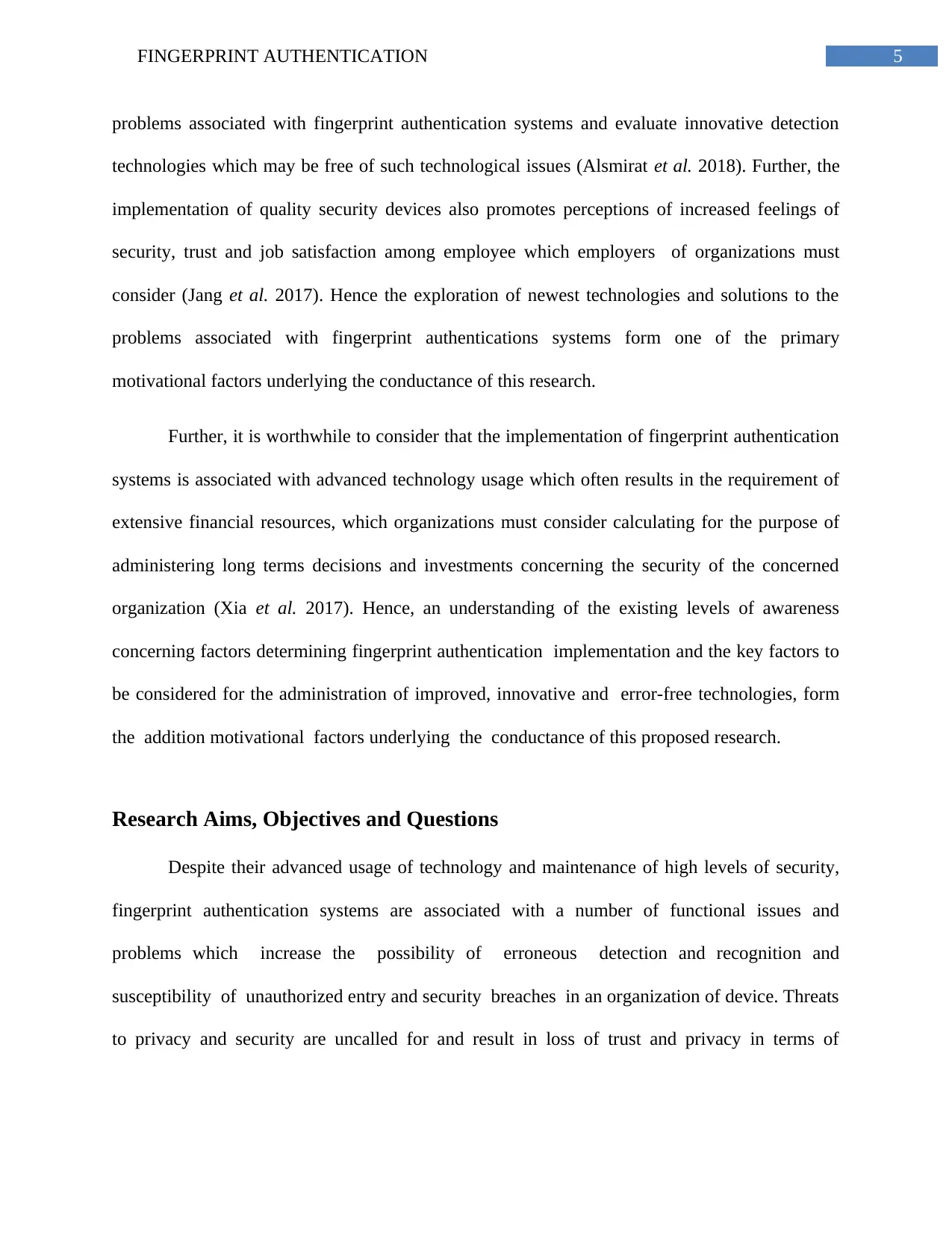
5FINGERPRINT AUTHENTICATION
problems associated with fingerprint authentication systems and evaluate innovative detection
technologies which may be free of such technological issues (Alsmirat et al. 2018). Further, the
implementation of quality security devices also promotes perceptions of increased feelings of
security, trust and job satisfaction among employee which employers of organizations must
consider (Jang et al. 2017). Hence the exploration of newest technologies and solutions to the
problems associated with fingerprint authentications systems form one of the primary
motivational factors underlying the conductance of this research.
Further, it is worthwhile to consider that the implementation of fingerprint authentication
systems is associated with advanced technology usage which often results in the requirement of
extensive financial resources, which organizations must consider calculating for the purpose of
administering long terms decisions and investments concerning the security of the concerned
organization (Xia et al. 2017). Hence, an understanding of the existing levels of awareness
concerning factors determining fingerprint authentication implementation and the key factors to
be considered for the administration of improved, innovative and error-free technologies, form
the addition motivational factors underlying the conductance of this proposed research.
Research Aims, Objectives and Questions
Despite their advanced usage of technology and maintenance of high levels of security,
fingerprint authentication systems are associated with a number of functional issues and
problems which increase the possibility of erroneous detection and recognition and
susceptibility of unauthorized entry and security breaches in an organization of device. Threats
to privacy and security are uncalled for and result in loss of trust and privacy in terms of
problems associated with fingerprint authentication systems and evaluate innovative detection
technologies which may be free of such technological issues (Alsmirat et al. 2018). Further, the
implementation of quality security devices also promotes perceptions of increased feelings of
security, trust and job satisfaction among employee which employers of organizations must
consider (Jang et al. 2017). Hence the exploration of newest technologies and solutions to the
problems associated with fingerprint authentications systems form one of the primary
motivational factors underlying the conductance of this research.
Further, it is worthwhile to consider that the implementation of fingerprint authentication
systems is associated with advanced technology usage which often results in the requirement of
extensive financial resources, which organizations must consider calculating for the purpose of
administering long terms decisions and investments concerning the security of the concerned
organization (Xia et al. 2017). Hence, an understanding of the existing levels of awareness
concerning factors determining fingerprint authentication implementation and the key factors to
be considered for the administration of improved, innovative and error-free technologies, form
the addition motivational factors underlying the conductance of this proposed research.
Research Aims, Objectives and Questions
Despite their advanced usage of technology and maintenance of high levels of security,
fingerprint authentication systems are associated with a number of functional issues and
problems which increase the possibility of erroneous detection and recognition and
susceptibility of unauthorized entry and security breaches in an organization of device. Threats
to privacy and security are uncalled for and result in loss of trust and privacy in terms of
⊘ This is a preview!⊘
Do you want full access?
Subscribe today to unlock all pages.

Trusted by 1+ million students worldwide
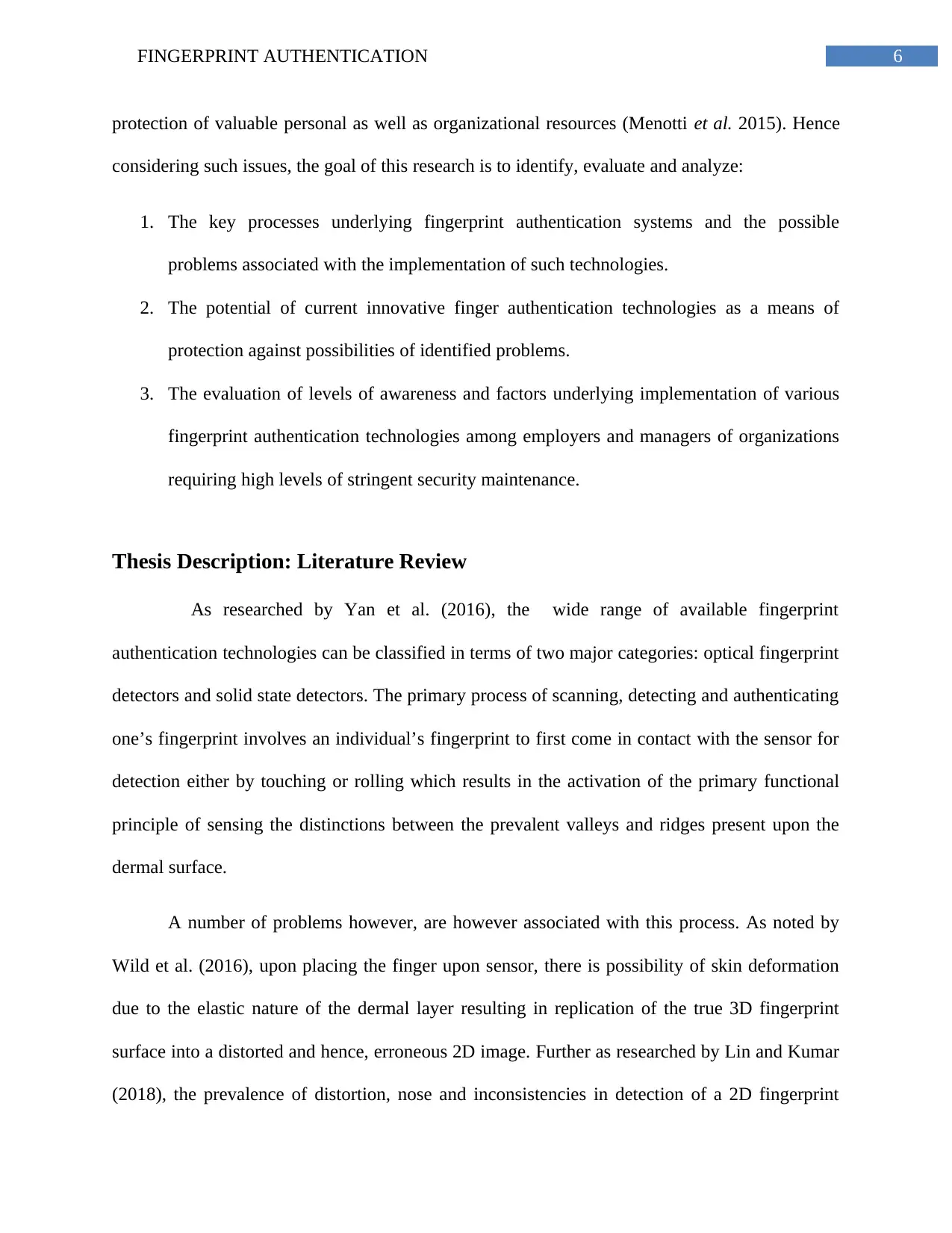
6FINGERPRINT AUTHENTICATION
protection of valuable personal as well as organizational resources (Menotti et al. 2015). Hence
considering such issues, the goal of this research is to identify, evaluate and analyze:
1. The key processes underlying fingerprint authentication systems and the possible
problems associated with the implementation of such technologies.
2. The potential of current innovative finger authentication technologies as a means of
protection against possibilities of identified problems.
3. The evaluation of levels of awareness and factors underlying implementation of various
fingerprint authentication technologies among employers and managers of organizations
requiring high levels of stringent security maintenance.
Thesis Description: Literature Review
As researched by Yan et al. (2016), the wide range of available fingerprint
authentication technologies can be classified in terms of two major categories: optical fingerprint
detectors and solid state detectors. The primary process of scanning, detecting and authenticating
one’s fingerprint involves an individual’s fingerprint to first come in contact with the sensor for
detection either by touching or rolling which results in the activation of the primary functional
principle of sensing the distinctions between the prevalent valleys and ridges present upon the
dermal surface.
A number of problems however, are however associated with this process. As noted by
Wild et al. (2016), upon placing the finger upon sensor, there is possibility of skin deformation
due to the elastic nature of the dermal layer resulting in replication of the true 3D fingerprint
surface into a distorted and hence, erroneous 2D image. Further as researched by Lin and Kumar
(2018), the prevalence of distortion, nose and inconsistencies in detection of a 2D fingerprint
protection of valuable personal as well as organizational resources (Menotti et al. 2015). Hence
considering such issues, the goal of this research is to identify, evaluate and analyze:
1. The key processes underlying fingerprint authentication systems and the possible
problems associated with the implementation of such technologies.
2. The potential of current innovative finger authentication technologies as a means of
protection against possibilities of identified problems.
3. The evaluation of levels of awareness and factors underlying implementation of various
fingerprint authentication technologies among employers and managers of organizations
requiring high levels of stringent security maintenance.
Thesis Description: Literature Review
As researched by Yan et al. (2016), the wide range of available fingerprint
authentication technologies can be classified in terms of two major categories: optical fingerprint
detectors and solid state detectors. The primary process of scanning, detecting and authenticating
one’s fingerprint involves an individual’s fingerprint to first come in contact with the sensor for
detection either by touching or rolling which results in the activation of the primary functional
principle of sensing the distinctions between the prevalent valleys and ridges present upon the
dermal surface.
A number of problems however, are however associated with this process. As noted by
Wild et al. (2016), upon placing the finger upon sensor, there is possibility of skin deformation
due to the elastic nature of the dermal layer resulting in replication of the true 3D fingerprint
surface into a distorted and hence, erroneous 2D image. Further as researched by Lin and Kumar
(2018), the prevalence of distortion, nose and inconsistencies in detection of a 2D fingerprint
Paraphrase This Document
Need a fresh take? Get an instant paraphrase of this document with our AI Paraphraser
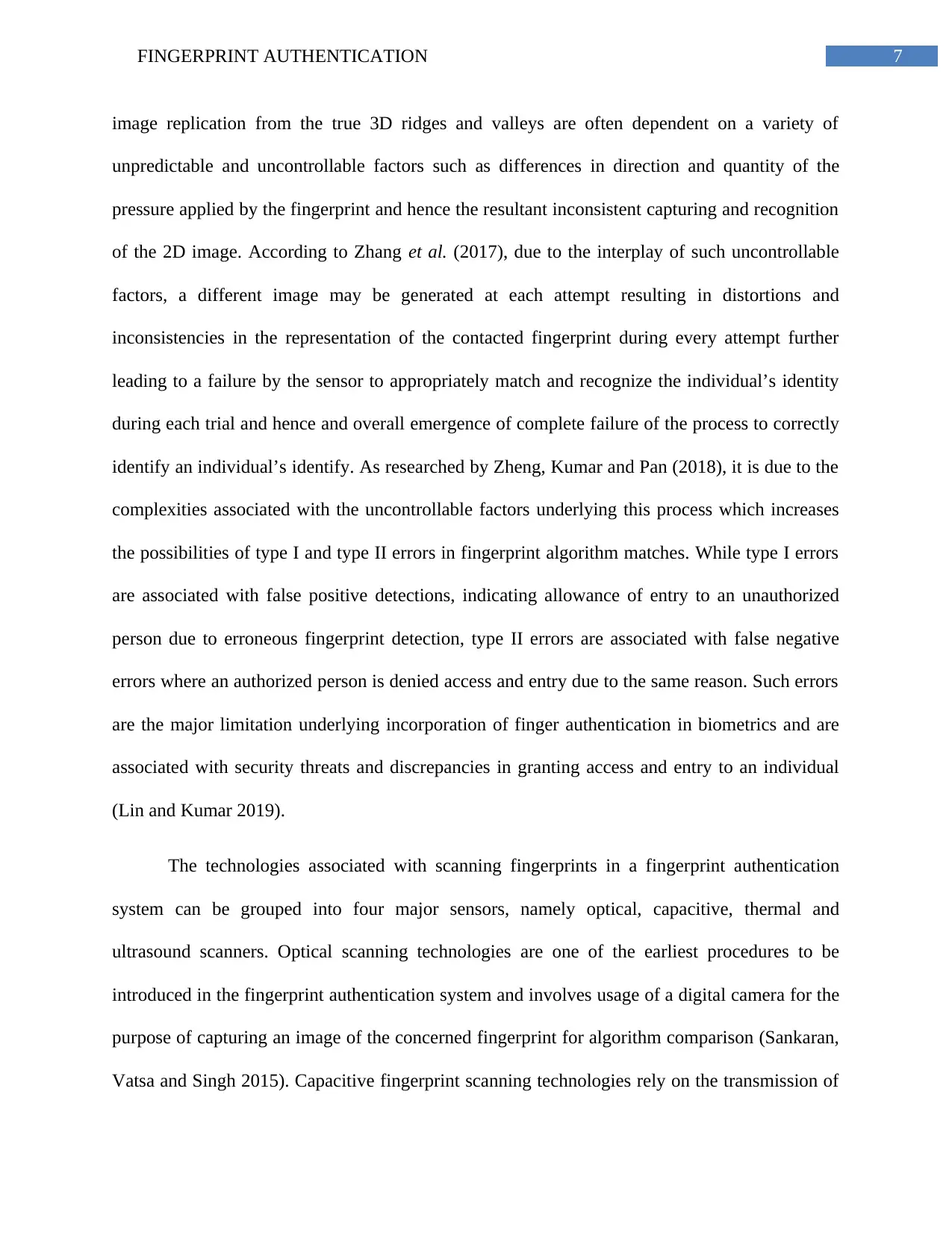
7FINGERPRINT AUTHENTICATION
image replication from the true 3D ridges and valleys are often dependent on a variety of
unpredictable and uncontrollable factors such as differences in direction and quantity of the
pressure applied by the fingerprint and hence the resultant inconsistent capturing and recognition
of the 2D image. According to Zhang et al. (2017), due to the interplay of such uncontrollable
factors, a different image may be generated at each attempt resulting in distortions and
inconsistencies in the representation of the contacted fingerprint during every attempt further
leading to a failure by the sensor to appropriately match and recognize the individual’s identity
during each trial and hence and overall emergence of complete failure of the process to correctly
identify an individual’s identify. As researched by Zheng, Kumar and Pan (2018), it is due to the
complexities associated with the uncontrollable factors underlying this process which increases
the possibilities of type I and type II errors in fingerprint algorithm matches. While type I errors
are associated with false positive detections, indicating allowance of entry to an unauthorized
person due to erroneous fingerprint detection, type II errors are associated with false negative
errors where an authorized person is denied access and entry due to the same reason. Such errors
are the major limitation underlying incorporation of finger authentication in biometrics and are
associated with security threats and discrepancies in granting access and entry to an individual
(Lin and Kumar 2019).
The technologies associated with scanning fingerprints in a fingerprint authentication
system can be grouped into four major sensors, namely optical, capacitive, thermal and
ultrasound scanners. Optical scanning technologies are one of the earliest procedures to be
introduced in the fingerprint authentication system and involves usage of a digital camera for the
purpose of capturing an image of the concerned fingerprint for algorithm comparison (Sankaran,
Vatsa and Singh 2015). Capacitive fingerprint scanning technologies rely on the transmission of
image replication from the true 3D ridges and valleys are often dependent on a variety of
unpredictable and uncontrollable factors such as differences in direction and quantity of the
pressure applied by the fingerprint and hence the resultant inconsistent capturing and recognition
of the 2D image. According to Zhang et al. (2017), due to the interplay of such uncontrollable
factors, a different image may be generated at each attempt resulting in distortions and
inconsistencies in the representation of the contacted fingerprint during every attempt further
leading to a failure by the sensor to appropriately match and recognize the individual’s identity
during each trial and hence and overall emergence of complete failure of the process to correctly
identify an individual’s identify. As researched by Zheng, Kumar and Pan (2018), it is due to the
complexities associated with the uncontrollable factors underlying this process which increases
the possibilities of type I and type II errors in fingerprint algorithm matches. While type I errors
are associated with false positive detections, indicating allowance of entry to an unauthorized
person due to erroneous fingerprint detection, type II errors are associated with false negative
errors where an authorized person is denied access and entry due to the same reason. Such errors
are the major limitation underlying incorporation of finger authentication in biometrics and are
associated with security threats and discrepancies in granting access and entry to an individual
(Lin and Kumar 2019).
The technologies associated with scanning fingerprints in a fingerprint authentication
system can be grouped into four major sensors, namely optical, capacitive, thermal and
ultrasound scanners. Optical scanning technologies are one of the earliest procedures to be
introduced in the fingerprint authentication system and involves usage of a digital camera for the
purpose of capturing an image of the concerned fingerprint for algorithm comparison (Sankaran,
Vatsa and Singh 2015). Capacitive fingerprint scanning technologies rely on the transmission of
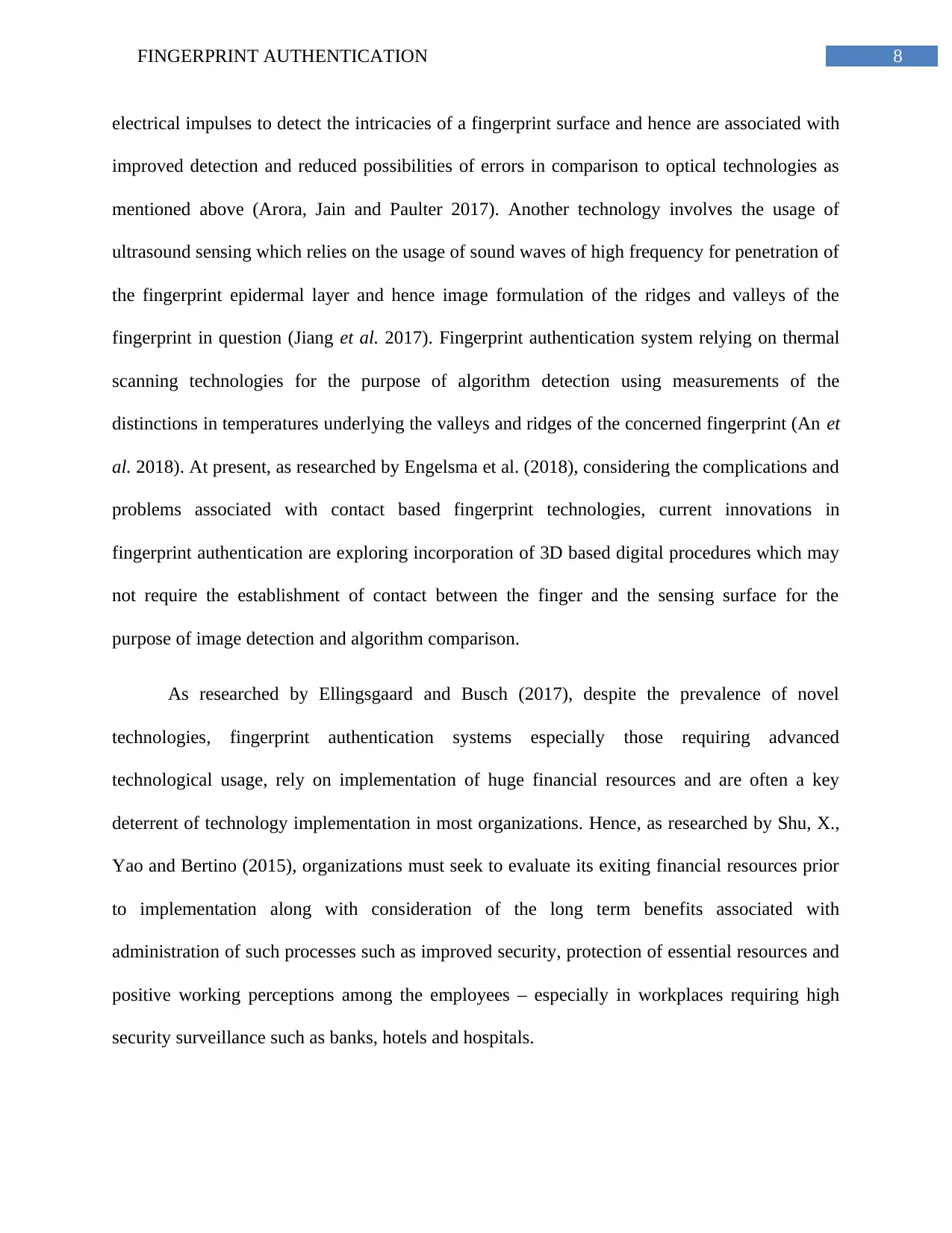
8FINGERPRINT AUTHENTICATION
electrical impulses to detect the intricacies of a fingerprint surface and hence are associated with
improved detection and reduced possibilities of errors in comparison to optical technologies as
mentioned above (Arora, Jain and Paulter 2017). Another technology involves the usage of
ultrasound sensing which relies on the usage of sound waves of high frequency for penetration of
the fingerprint epidermal layer and hence image formulation of the ridges and valleys of the
fingerprint in question (Jiang et al. 2017). Fingerprint authentication system relying on thermal
scanning technologies for the purpose of algorithm detection using measurements of the
distinctions in temperatures underlying the valleys and ridges of the concerned fingerprint (An et
al. 2018). At present, as researched by Engelsma et al. (2018), considering the complications and
problems associated with contact based fingerprint technologies, current innovations in
fingerprint authentication are exploring incorporation of 3D based digital procedures which may
not require the establishment of contact between the finger and the sensing surface for the
purpose of image detection and algorithm comparison.
As researched by Ellingsgaard and Busch (2017), despite the prevalence of novel
technologies, fingerprint authentication systems especially those requiring advanced
technological usage, rely on implementation of huge financial resources and are often a key
deterrent of technology implementation in most organizations. Hence, as researched by Shu, X.,
Yao and Bertino (2015), organizations must seek to evaluate its exiting financial resources prior
to implementation along with consideration of the long term benefits associated with
administration of such processes such as improved security, protection of essential resources and
positive working perceptions among the employees – especially in workplaces requiring high
security surveillance such as banks, hotels and hospitals.
electrical impulses to detect the intricacies of a fingerprint surface and hence are associated with
improved detection and reduced possibilities of errors in comparison to optical technologies as
mentioned above (Arora, Jain and Paulter 2017). Another technology involves the usage of
ultrasound sensing which relies on the usage of sound waves of high frequency for penetration of
the fingerprint epidermal layer and hence image formulation of the ridges and valleys of the
fingerprint in question (Jiang et al. 2017). Fingerprint authentication system relying on thermal
scanning technologies for the purpose of algorithm detection using measurements of the
distinctions in temperatures underlying the valleys and ridges of the concerned fingerprint (An et
al. 2018). At present, as researched by Engelsma et al. (2018), considering the complications and
problems associated with contact based fingerprint technologies, current innovations in
fingerprint authentication are exploring incorporation of 3D based digital procedures which may
not require the establishment of contact between the finger and the sensing surface for the
purpose of image detection and algorithm comparison.
As researched by Ellingsgaard and Busch (2017), despite the prevalence of novel
technologies, fingerprint authentication systems especially those requiring advanced
technological usage, rely on implementation of huge financial resources and are often a key
deterrent of technology implementation in most organizations. Hence, as researched by Shu, X.,
Yao and Bertino (2015), organizations must seek to evaluate its exiting financial resources prior
to implementation along with consideration of the long term benefits associated with
administration of such processes such as improved security, protection of essential resources and
positive working perceptions among the employees – especially in workplaces requiring high
security surveillance such as banks, hotels and hospitals.
⊘ This is a preview!⊘
Do you want full access?
Subscribe today to unlock all pages.

Trusted by 1+ million students worldwide
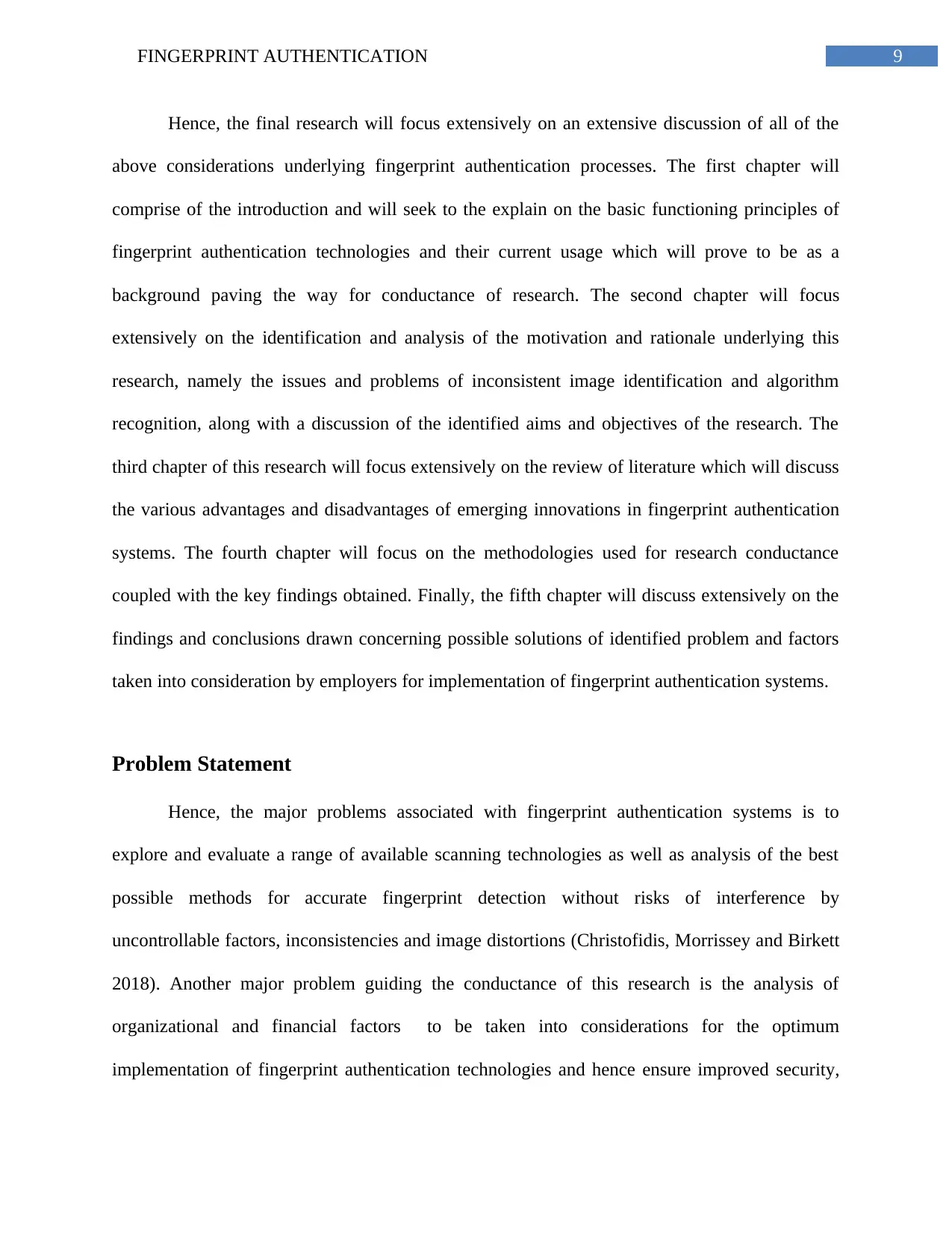
9FINGERPRINT AUTHENTICATION
Hence, the final research will focus extensively on an extensive discussion of all of the
above considerations underlying fingerprint authentication processes. The first chapter will
comprise of the introduction and will seek to the explain on the basic functioning principles of
fingerprint authentication technologies and their current usage which will prove to be as a
background paving the way for conductance of research. The second chapter will focus
extensively on the identification and analysis of the motivation and rationale underlying this
research, namely the issues and problems of inconsistent image identification and algorithm
recognition, along with a discussion of the identified aims and objectives of the research. The
third chapter of this research will focus extensively on the review of literature which will discuss
the various advantages and disadvantages of emerging innovations in fingerprint authentication
systems. The fourth chapter will focus on the methodologies used for research conductance
coupled with the key findings obtained. Finally, the fifth chapter will discuss extensively on the
findings and conclusions drawn concerning possible solutions of identified problem and factors
taken into consideration by employers for implementation of fingerprint authentication systems.
Problem Statement
Hence, the major problems associated with fingerprint authentication systems is to
explore and evaluate a range of available scanning technologies as well as analysis of the best
possible methods for accurate fingerprint detection without risks of interference by
uncontrollable factors, inconsistencies and image distortions (Christofidis, Morrissey and Birkett
2018). Another major problem guiding the conductance of this research is the analysis of
organizational and financial factors to be taken into considerations for the optimum
implementation of fingerprint authentication technologies and hence ensure improved security,
Hence, the final research will focus extensively on an extensive discussion of all of the
above considerations underlying fingerprint authentication processes. The first chapter will
comprise of the introduction and will seek to the explain on the basic functioning principles of
fingerprint authentication technologies and their current usage which will prove to be as a
background paving the way for conductance of research. The second chapter will focus
extensively on the identification and analysis of the motivation and rationale underlying this
research, namely the issues and problems of inconsistent image identification and algorithm
recognition, along with a discussion of the identified aims and objectives of the research. The
third chapter of this research will focus extensively on the review of literature which will discuss
the various advantages and disadvantages of emerging innovations in fingerprint authentication
systems. The fourth chapter will focus on the methodologies used for research conductance
coupled with the key findings obtained. Finally, the fifth chapter will discuss extensively on the
findings and conclusions drawn concerning possible solutions of identified problem and factors
taken into consideration by employers for implementation of fingerprint authentication systems.
Problem Statement
Hence, the major problems associated with fingerprint authentication systems is to
explore and evaluate a range of available scanning technologies as well as analysis of the best
possible methods for accurate fingerprint detection without risks of interference by
uncontrollable factors, inconsistencies and image distortions (Christofidis, Morrissey and Birkett
2018). Another major problem guiding the conductance of this research is the analysis of
organizational and financial factors to be taken into considerations for the optimum
implementation of fingerprint authentication technologies and hence ensure improved security,
Paraphrase This Document
Need a fresh take? Get an instant paraphrase of this document with our AI Paraphraser
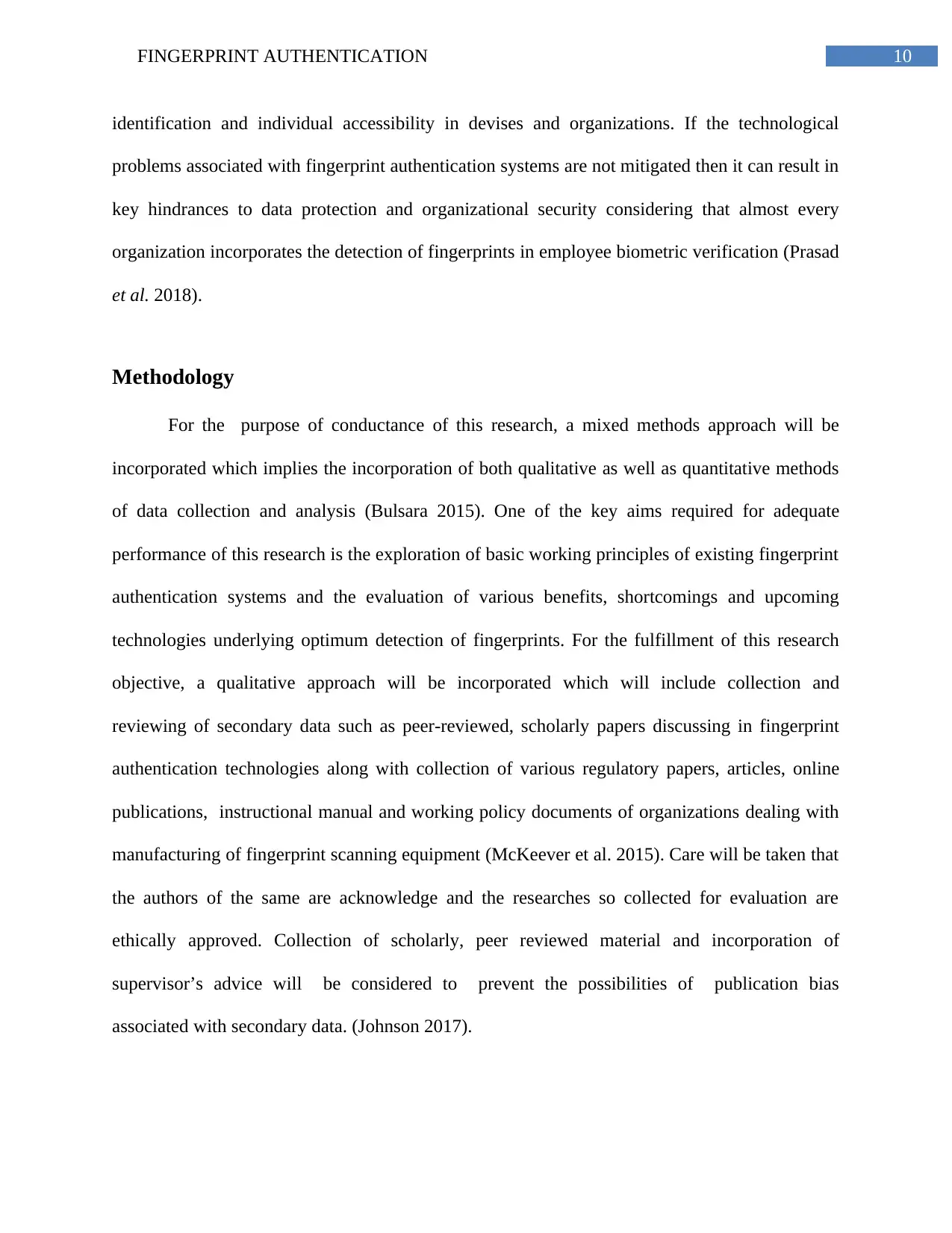
10FINGERPRINT AUTHENTICATION
identification and individual accessibility in devises and organizations. If the technological
problems associated with fingerprint authentication systems are not mitigated then it can result in
key hindrances to data protection and organizational security considering that almost every
organization incorporates the detection of fingerprints in employee biometric verification (Prasad
et al. 2018).
Methodology
For the purpose of conductance of this research, a mixed methods approach will be
incorporated which implies the incorporation of both qualitative as well as quantitative methods
of data collection and analysis (Bulsara 2015). One of the key aims required for adequate
performance of this research is the exploration of basic working principles of existing fingerprint
authentication systems and the evaluation of various benefits, shortcomings and upcoming
technologies underlying optimum detection of fingerprints. For the fulfillment of this research
objective, a qualitative approach will be incorporated which will include collection and
reviewing of secondary data such as peer-reviewed, scholarly papers discussing in fingerprint
authentication technologies along with collection of various regulatory papers, articles, online
publications, instructional manual and working policy documents of organizations dealing with
manufacturing of fingerprint scanning equipment (McKeever et al. 2015). Care will be taken that
the authors of the same are acknowledge and the researches so collected for evaluation are
ethically approved. Collection of scholarly, peer reviewed material and incorporation of
supervisor’s advice will be considered to prevent the possibilities of publication bias
associated with secondary data. (Johnson 2017).
identification and individual accessibility in devises and organizations. If the technological
problems associated with fingerprint authentication systems are not mitigated then it can result in
key hindrances to data protection and organizational security considering that almost every
organization incorporates the detection of fingerprints in employee biometric verification (Prasad
et al. 2018).
Methodology
For the purpose of conductance of this research, a mixed methods approach will be
incorporated which implies the incorporation of both qualitative as well as quantitative methods
of data collection and analysis (Bulsara 2015). One of the key aims required for adequate
performance of this research is the exploration of basic working principles of existing fingerprint
authentication systems and the evaluation of various benefits, shortcomings and upcoming
technologies underlying optimum detection of fingerprints. For the fulfillment of this research
objective, a qualitative approach will be incorporated which will include collection and
reviewing of secondary data such as peer-reviewed, scholarly papers discussing in fingerprint
authentication technologies along with collection of various regulatory papers, articles, online
publications, instructional manual and working policy documents of organizations dealing with
manufacturing of fingerprint scanning equipment (McKeever et al. 2015). Care will be taken that
the authors of the same are acknowledge and the researches so collected for evaluation are
ethically approved. Collection of scholarly, peer reviewed material and incorporation of
supervisor’s advice will be considered to prevent the possibilities of publication bias
associated with secondary data. (Johnson 2017).
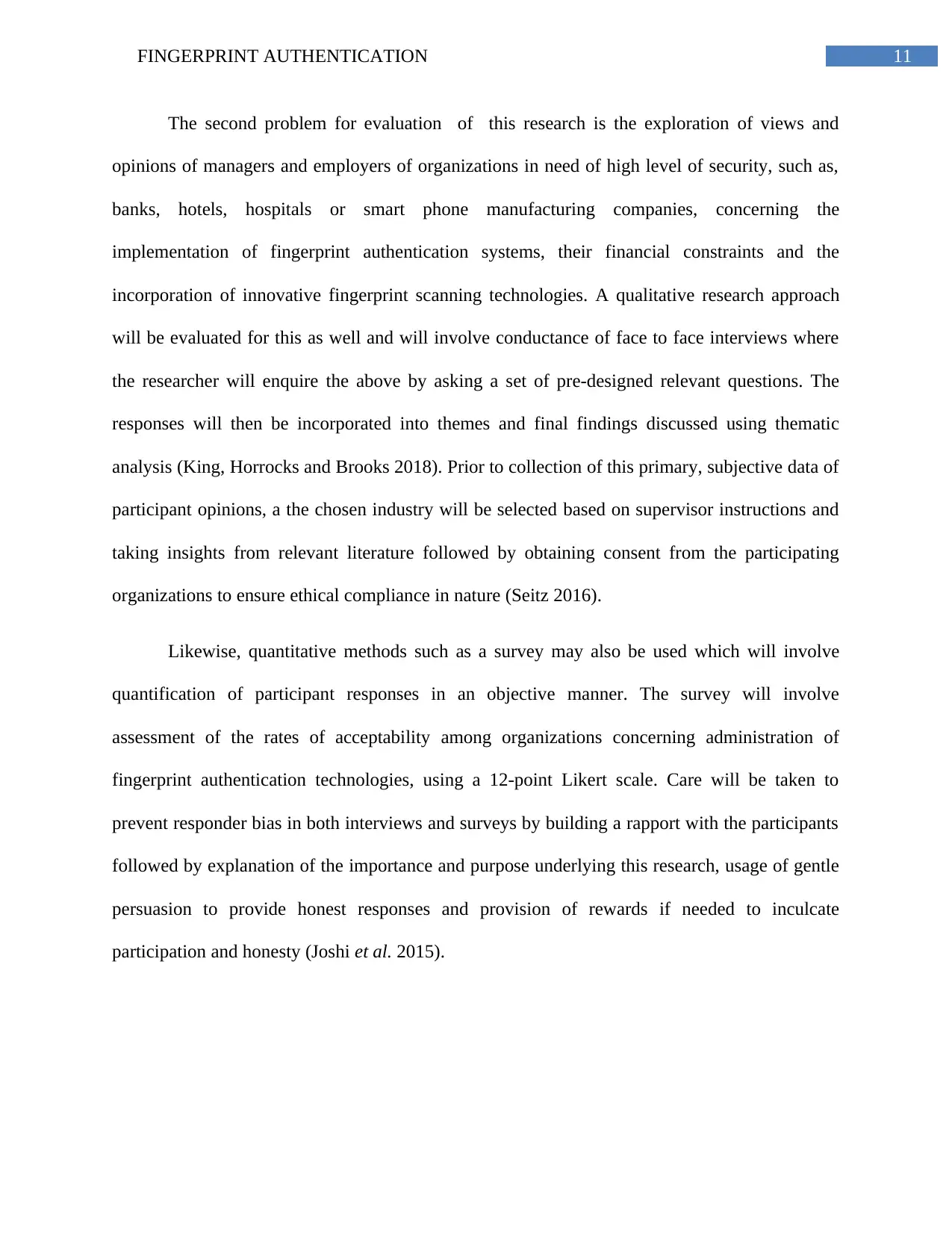
11FINGERPRINT AUTHENTICATION
The second problem for evaluation of this research is the exploration of views and
opinions of managers and employers of organizations in need of high level of security, such as,
banks, hotels, hospitals or smart phone manufacturing companies, concerning the
implementation of fingerprint authentication systems, their financial constraints and the
incorporation of innovative fingerprint scanning technologies. A qualitative research approach
will be evaluated for this as well and will involve conductance of face to face interviews where
the researcher will enquire the above by asking a set of pre-designed relevant questions. The
responses will then be incorporated into themes and final findings discussed using thematic
analysis (King, Horrocks and Brooks 2018). Prior to collection of this primary, subjective data of
participant opinions, a the chosen industry will be selected based on supervisor instructions and
taking insights from relevant literature followed by obtaining consent from the participating
organizations to ensure ethical compliance in nature (Seitz 2016).
Likewise, quantitative methods such as a survey may also be used which will involve
quantification of participant responses in an objective manner. The survey will involve
assessment of the rates of acceptability among organizations concerning administration of
fingerprint authentication technologies, using a 12-point Likert scale. Care will be taken to
prevent responder bias in both interviews and surveys by building a rapport with the participants
followed by explanation of the importance and purpose underlying this research, usage of gentle
persuasion to provide honest responses and provision of rewards if needed to inculcate
participation and honesty (Joshi et al. 2015).
The second problem for evaluation of this research is the exploration of views and
opinions of managers and employers of organizations in need of high level of security, such as,
banks, hotels, hospitals or smart phone manufacturing companies, concerning the
implementation of fingerprint authentication systems, their financial constraints and the
incorporation of innovative fingerprint scanning technologies. A qualitative research approach
will be evaluated for this as well and will involve conductance of face to face interviews where
the researcher will enquire the above by asking a set of pre-designed relevant questions. The
responses will then be incorporated into themes and final findings discussed using thematic
analysis (King, Horrocks and Brooks 2018). Prior to collection of this primary, subjective data of
participant opinions, a the chosen industry will be selected based on supervisor instructions and
taking insights from relevant literature followed by obtaining consent from the participating
organizations to ensure ethical compliance in nature (Seitz 2016).
Likewise, quantitative methods such as a survey may also be used which will involve
quantification of participant responses in an objective manner. The survey will involve
assessment of the rates of acceptability among organizations concerning administration of
fingerprint authentication technologies, using a 12-point Likert scale. Care will be taken to
prevent responder bias in both interviews and surveys by building a rapport with the participants
followed by explanation of the importance and purpose underlying this research, usage of gentle
persuasion to provide honest responses and provision of rewards if needed to inculcate
participation and honesty (Joshi et al. 2015).
⊘ This is a preview!⊘
Do you want full access?
Subscribe today to unlock all pages.

Trusted by 1+ million students worldwide
1 out of 18
Related Documents
Your All-in-One AI-Powered Toolkit for Academic Success.
+13062052269
info@desklib.com
Available 24*7 on WhatsApp / Email
![[object Object]](/_next/static/media/star-bottom.7253800d.svg)
Unlock your academic potential
Copyright © 2020–2025 A2Z Services. All Rights Reserved. Developed and managed by ZUCOL.




